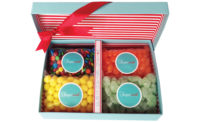How Asian candies are making a mark on the confectionery industry
Candies from the Far East have yet to become mainstream, but the right marketing efforts could change that.
















Asian snacks and candies aren’t easy to find in the United States. Outside of Chinatown or Asian supermarkets like H Mart, they’re a rare commodity.
Considering they’re foreign imports, it’s not too surprising that they’re hard to find. But next to the popularity of European confections, you have to wonder why Asian candies have yet to become mainstream.
So we went looking for answers.
Peilin Pratt, v.p. of CandyWarehouse.com, gave us some insight. The online retailer hasn’t seen a huge reception when it comes to Asian candy, but it tends to sell well regionally. Mostly, it’s in states or areas with larger Asian populations, like California.
“To us, it seems like people eating Asian candy are still Asians, or non-Asians who have some history or relationships or family members, or they’ve traveled to Asia,” says Pratt.
That’s a very general statement, she admits, but the fact is that apart from brands like Pocky and Hi-Chew, there are very few Asian candies that mainstream America is really aware of.
There could be several reasons for this.
For one, a lot of Asian candies have names and packaging that are still written in foreign languages. While Hi-Chew is an easily recognizable name, there are others like Kasugai Nodo Ni Sukkiri Fruit Candy and Lion Soda Hard Candy Balls that are both hard to remember and hard to make sense of.
All of that, says Pratt, seems to say that a lot of manufacturers haven’t made a huge effort to jump into the American market. The packaging simply isn’t geared toward English-speaking consumers.
Another obstacle Asian candy faces is, perhaps, simply a lack of education.
“I like to compare it to ethnic food,” says Pratt. “A few decades ago, people probably thought eating sushi was weird. But now it’s become very mainstream, and even the guy in Oklahoma will eat sushi.”
With candy, though, it might be more difficult. It’s not quite like ethnic food, which people might try when they’re looking for something new. Candy is much more tied to people’s childhoods. It evokes a sense of nostalgia, which could make consumers less likely to stray from the brands they’ve known since they were young.
According to Mintel’s Chocolate Confectionery – U.S. – February 2015 report, “Chocolate confectionery is a mature category with a loyal consumer base. Leading brands are widely familiar, and evoke images of nostalgia, fun, and quality.”
So it all comes down to getting the word out. Pratt thinks Asian candy has huge potential, but manufacturers need to invest in educating the market and making their products easy to understand.
Brand recognition is huge, after all. It’s helped Pocky gain a growing fanbase in the United States.
For Pocky, there’s an interesting combination of an existing fanbase benefitting from increased distribution, and new consumers discovering the snacks as something novel they can enjoy, says Mike Parise, a Glico representative.
Pocky reaches both of those audiences through sampling tours that provide individual interactions, which help spread the word through social networks both online and off. And since distribution has hardly been maximized, there’s always room to grow. New flavors, textures and packaging can drive interest and satisfy the demand for new experiences.
Distribution, of course, is a major concern for any brand, and ease of distribution is key.
Meiji, a leading confectioner in Japan, sells three items in the United States: Hello Panda, Yan Yan, andChocoroom.
“Our goal at Meiji America is to gain distribution in confectionery and snack sections of mainstream supermarkets in addition to Asian food sections where we are most frequently located,” says Charlie Alford, v.p. of business development, D.F. Stauffer Biscuit Co.
They currently manufacture and distribute Hello Panda in the United States and plan to start domestic production of Yan Yan in 2016. That will allow them to be more responsive to customer and consumer demands and be more innovative, which creates category news and brand awareness, says Alford.
That all can only help when it comes to spreading the word on Meiji’s whimsical products. Hello Panda, a crunchy cookie shell filled with chocolate, strawberry, or vanilla cream and printed with panda characters doing different sports, is a fun snack that tastes great and appeals to children and adults alike.
But Asian brands certainly have a tough battle to fight. While the whole world knows about brands like Hershey andM&Ms, few Asian candies can boast anything close to that kind of brand recognition.
Still, Pratt thinks there’s untapped potential.
“I don’t think quality is an issue. The quality is great, especially the Japanese brand candies,” she says. “The flavors are really distinct and flavorful. I don’t think it’s the product itself. It’s just that somehow it hasn’t made it into the mainstream palate.”
With the right marketing efforts, though, Asian confections could slowly become part of mainstream American tastes.
Looking for a reprint of this article?
From high-res PDFs to custom plaques, order your copy today!

















